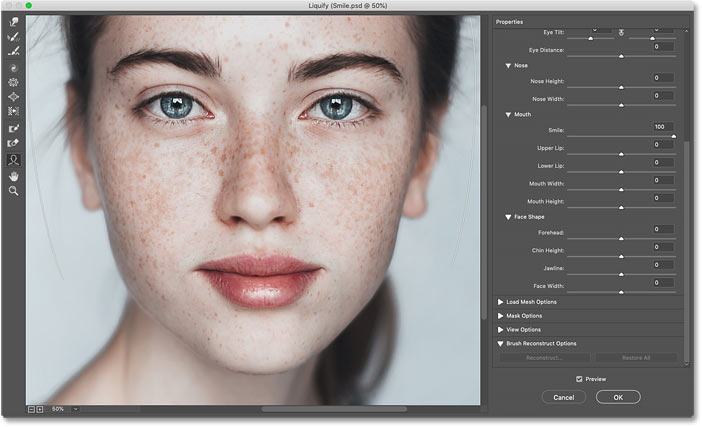
- WHERE IS PHOTOSHOP LIQUIFY TOOL HOW TO
- WHERE IS PHOTOSHOP LIQUIFY TOOL PROFESSIONAL
- WHERE IS PHOTOSHOP LIQUIFY TOOL FREE
While holding the Option key, you can click on the centered square on the right side of your image and drag slowly toward the edge of your image. Now we can access the Content Aware Tool by holding Shift + Option + Command and striking the “C” key. Instead, right-click on the layer and choose Rasterize Layer. I think this is a little sloppy unless you have a seamless backdrop.

You could simply create a layer mask on your transformed Smart Object layer and paint in the base layer. Click on the layer you want to duplicate and hold Option + Command while striking the “J” key. Always duplicate your base or background layer. This is why working on separate layers is so important. Enter the Content Aware Tool by going to the menu bar and clicking Edit.

Now we need to extend our edge back to the original image dimensions. We instantly can start slimming down your client. While holding the Option key, click on the centered square on the right side of your image and drag slowly toward the center of your image. Why would this be a concern? You can use the very simple Transform tool for thinning, quickly accessed by holding Command and the “T” key. Remember, with Smart Objects, you are limited to certain pixel manipulation tools like Content Aware Scale. This is quite different from the Camera Raw filter in that you have to start from scratch since it’s editing without the previous metadata applied. This is an awesome feature that allows for a nondestructive edit all the way back to your Raw settings. Start by double-clicking the preview of your image on the base layer, and you are taken directly back into ACR with your settings still saved. Check out Adobe’s website for recommended computer hardware. These Smart Object-type image files will get rather large hopefully you have some decent processing power.
WHERE IS PHOTOSHOP LIQUIFY TOOL FREE
This doesn’t mean you just won free pixels from Photoshop. After your image opens, you’ll notice the size of the document is larger than normal. Let’s check this box and begin exploring. Here is a quick breakdown of what this unique file type does for us. I leave Output Sharpening unchecked because I will manually sharpen in Photoshop later.Īs part of the most important feature of Photoshop, there is a checkbox for Open in Photoshop as Smart Objects. Don’t worry about this-we are not adding or subtracting pixels here. I set resolution to 300 when I’m planning to print images. You’ll notice Adobe 1998 is default and is a suitable color space for a working image in Photoshop. Access these by clicking on the text at the very bottom of the ACR screen displaying color space, bit depth, resolution, camera sensor size and PPI. Let’s keep moving.Īfter making our basic color correction adjustments, we need to adjust some Workflow Options before opening our Raw files in Photoshop. For pincushion distortion, it’s going to make the subject wider. Checking this box can sometimes be half the battle. We want to remove lens distortion altogether before we start slimming the face and body. Another important element is Lens Correction. I typically leave Clarity and Vibrance set to zero when retouching images. Let’s jump into Adobe Camera Raw (ACR) and review our settings. Consider this workflow even when you have delivered creative edits to your client. Make your life simple and edit from the Raw file that has been merely color-corrected for basic exposure, color and tone adjustments. You are probably wondering at what stage in the post-production you should start retouching. Put your feelings aside and consider using these tips for your post-processing. Reader beware: We are going to thin real clients and show what else this tool can do.
WHERE IS PHOTOSHOP LIQUIFY TOOL HOW TO
This article takes you through the do’s and don’ts of Liquify and how to navigate through the Liquify panel in Photoshop CC. Stop saying your photography is pure, and get up to speed with the industry. If I haven’t lost you with the title of this article and you think your clients should remain untouched, as they appeared through your lens, think again. This is a bad move unless your client requests it. The last thing you want to do is make them look 30 pounds lighter because you think they will be happier with their images. The sensitivity of your client should come into play as well. When it’s obvious that an image has been altered from reality, it’s just tacky.

When you retouch clients, your changes can’t be noticeable.

WHERE IS PHOTOSHOP LIQUIFY TOOL PROFESSIONAL
Shutter Magazine is the industry’s leading professional photography magazine. Launch the July issue of the magazine by logging in or signing up for a free account by clicking here. Want more information on this article? Get access to video content and additional supporting images. Tighten Up the Loose Ends: Liquify Tool in Photoshop CC 2017 with Dustin Lucas


 0 kommentar(er)
0 kommentar(er)
